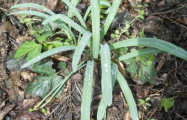The rich flora of the Azerbaijan Republic and its variegated plants are due to the diversity of its physical-geographical and natural-historical conditions and its complex history that formed under the influence of distant floristic areas.
There are 247,352 hectares of forests left in Azerbaijan`s Armenian-occupied territories. Most of the plants here are endemic species and do not naturally grow in any other part of the world.
The following are the main plant species of Karabakh:
Hircanus ilex tree – holly (Ilex hyrcana Pojark) – It is a relict endangered species. It grows around the villages of Badara and Dashalti near Khankandi. It also sparsely grows as a shrub in beech, beech-hornbeam and mixed forests.
Caucasian snowdrop (Galanthus caucasicus (Baker), A.Gross) – It belongs to the genus Galanthus and is a rare species with a shrinking habitat. It grows in Shusha (near Kechal-Qaya and Topkhana). It normally grows near trees and shrubs in relatively open parts and edges of forests. There are very few plants left.
Komarov pyrethrum – It belongs to the genus Chrysanthemum and is a rare endemic species in Azerbaijan. It grows on rocks in the alpine zone of Nagorno Karabakh. This species is very rare.
Fine serpent root (Scorzonera pulchra Lomak) – It belongs to the genus Chrysanthemum and is a very rare endemic species. In Azerbaijan, it can be found only on Mount Ziyarat and in the Topkhana area in Khojavand District of Nagorno Karabakh. It grows on rocky and gravel slopes from the middle mountain zone to the subalpine zone.
Telekia speciosa – it belongs to the genus Chrysanthemum and is a rare species. It is common in Nagorno Karabakh and in the village of Yukhari Ayrim in Kalbajar. It grows in high grass and mountain meadows from the middle mountain zone to the sub-alpine zone. It can be found only one by one.
Velvety euonymus (Euonymus velutina Fisch. et Mey) – It belongs to the genus Euonymus and is a rare relict species. It is common in Khojavand District in Upper Garabagh and grows in sunlit forests, mountain slopes and gorges at heights of up to 1,800 metres.
Tree-like storax – it belongs to the genus Styrax and is a rare endangered relict species. It grows in the Chichakli forest in Kalbajar District and randomly in the middle mountain zone (1,000-1,700 above sea level), broad-leaved beech-hornbeam and oak-hornbeam forests.
Ordinary chestnut – It belongs to genus Styrax and is a relict species with a shrinking natural habitat. It is common around Khankandi in Upper Garabagh. It grows on humid clayey soil on the northern slopes of the mountain zone at a height of 600-1,100 metres, mountain valleys and on gorge slopes.
Araz oak – It belongs to the genus Fagus and is a rare endemic species. It is common in Zangilan District (around the villages of Bartaz, Goyali, Ordakli, Sayifli, Kechikli and Yukhari Yemazli) and grows in the lower mountain zone at a height of 1,000-1,300 above sea level. It forms thin xerophytic forests. It was protected as a rare plant in an area of 10,000 hectares in Zangilan.
Gladiolus halophilus – it belongs to the genus Gladiolus and is common around Zangilan District. It is believed to be an extinct species.
Garabagh poppy (Tulpa karabachensis Gross) – It belongs to the genus Tulipa and is a rare endemic species in the South Caucasus. It is common around Shusha and in the villages of Topkhana, Domu, Tag and Tug in Nagornyy Karabakh. It grows on stone-gravel slopes at a height of up to 1,800 metres above sea level and is very rare.
Schmidt black poppy (Tulipa schmidtii Fomin) - It belongs to the genus Tulipa and is an endangered endemic species typical of the South Caucasus. It is common in Khojavand, Shusha and Jabrayil districts and grows as a shrub in dry and grass slopes.
Sagsagan hollyhock (Alcea sachsashanica Iljin) – it belongs to the Malvaceae family and is a rare endemic species in Azerbaijan. It is common in Khankandi, Shusha (Mount Sagsagan and Mount Jidirduzu) and Khojavand. It grows on dry stone slopes at a height of up to 1,700 above sea level.
Sword-leaved Helleborine (Cephalanthera longifolia (L) Fritsjh) - It is a rare species with a shrinking natural habitat. It is common around Khankandi and grows in lower and middle mountain zones and brushwoods.
Caucasian fly orchid (Ophrys caucasica Woronow ex Grossh) – It is a rare endemic species in the Caucasus and grows in Jabrayil and Qubadli districts, between rocks in middle mountain zones, grass slopes, forest edges and shrubs.
Natam limodorum – it is a rare monotypic pedigree plant species and grows in thin forests in Nagorno Karabakh, among shrubs and forests edges.
Oriental plane (Platanus orientalis L. (P. digitifolia Palb)) – It is a rare endangered species and is common in the Basitchay and Okhchuchay valleys in Zangilan District and in Agdara. It grows on riverbanks and areas made humid by underground waters in gorges at a height of up to 1,000 metres. It was protected at the Basitchay State Nature Reserve.
Einkorn (Triticum monococcum L) – it is a very rare species and is common around Khankandi and the Topkhana forest in Nagorno Karabakh, as well as in Shusha and Lachin districts. It grows on futile dry, gravel, sand and clayey slopes and is of special selective importance.
Ordinary pomegranate – it is a rare relict species and is common in Zangilan and Jabrayil districts. It grows on dry slopes and in river valleys.
Ordinary forest cherry – It is a rare endangered species and is common in Lachin and Agdara districts. It grows mainly in mountain zones, forest edges and in broad-leaved forests.
Red pyracantha (Pyracantha coccinea Roem) – It is a rare species typical of the Eastern Mediterranean. It is common near Shusha and in the village of Dashalti in Nagorno Karabakh. It is common in gravel areas, forest edges, thin forests and shrubs at a height of up to 1,800 metres above sea level.
Caucasian deadly nightshade – it is a rare endangered European species with a shrinking natural habitat. It grows in beech forests of the Lesser Caucasus, on roadsides and in gorges.
Coniferous yew (Taxus baccata L) – It is a rare relict species and is common in Khojavand and Kalbajar districts. It grows in beech-hornbeam forests at a height of up to 1,900 above sea level. It is necessary to organize the protection and cultivation of the existing trees.
Caucasian laurel – it is a rare plant species with a shrinking natural habitat and is common in Jabrayil and Qubadli districts. It grows on alabaster and limestone dry slopes beginning from the middle mountain zone to a height of up to 2,900 metres.
Zelkova carpinifolia (Zelkova carpinifofolia (Pall) C.Koch. (Z.hyrcana Grossh. Et Jarm)) – It is a rare relict plant in the Caucasus and Iran. It is common in Khankandi and Shusha in Nagornyy Garabagh, as well as in Khojavand and Fizuli districts. It grows in forests mixed with the Georgian oak or in its own forests in the southeastern part of Garabagh.
Wild vine (Vitis silvestris Gmel) – it is a rare endangered species and is common in Khojavand and Zangilan (Agband village) districts. It grows along rivers and in forests.
Alpine flower-cup fern – It is a very rare arctalpine relict species and grows in Jabrayil District. It grows in rocky cracks in upper mountain and alpine zones, as well as in stone and rocky areas. It is of great decorative and scientific importance.
Stinking juniper (Juniperus foetidissima Willd) – it is a rare species and grows on rocky and dry slopes in lower and middle mountain zones at a height of up to 1,000 metres. It is common in the villages of Chullu, Qazanzami and Shikhlar in Jabrayil District.
Stenbergia fischeriana (Sternbergia fischeriana (Herb) Roem) – it is a rare species with a shrinking natural habitat. It grows mainly on dry slopes in middle and lower mountain zones and is common in the Topkhana area of Shusha District, near the villages of Goytapa in Agdam District and the village of Dovlatyarli (Qarakopaktapa and Yelligadik areas) in Fizuli District.
Hircanus fig (Ficus hyrcana Grossh) – it is a rare endemic plant species in Azerbaijan and grows in humid-moderate climatic conditions. It is common near Shusha and Khankandi.
Iris acutiloba (İris acutiloba C.A.Mey) – it is a rare endemic Caucasian plant with a restricted natural habitat. It grows in dry clayey, sandy and rocky slopes and seafront sand and is common in Khojavand (near the village of Kuropatkino) and around Shusha (Topkhana).
Camilla iris (Iris camillae Grossh) – it is a rare restricted endemic species. It grows on dry gravel and rocky slopes and is common around Agdam and Asgaran.
Kuzetsov windflower (Anemone kusnetzowii Woronow ex Grossh) – It is a rare South Caucasus endemic species and grows in lower mountain zones and shrubs. In the former Soviet Union, it grew only in Azerbaijan – between the villages of Dashkasan and Guzlah in Jabrayil District.
Acantholimon tenuiflorum (Acantholimon tenutiflorum Boiss) – It is a rare endemic species with a restricted natural habitat in Azerbaijan and grows on dry clayey and gravel slopes. It is common near the village of Borsunlu in Tartar District.
Tulipa schmidtii (Tulipa schmidtii Fomin) – It is a rare species of North Iranian origin and grows on dry lime and rocky slopes. It is common in the area around the village of Soltanli.
Azerbaijani white rose (dog-rose) (Rosa Azerbajdzhanica Novopokr et Rzazade) – It is a rare endemic species in Azerbaijan and grows on the rocky and gravel slopes of the middle mountain zone. It is common around the town of Kalbajar.
Hog`s fennel (Peucedanum pauciradiatum Tamasch) – it is a rare endemic species (Caucasus) and grows on dry rocky and gravel slopes of the lower and middle mountain zones. It is common around the village of Agband in Zangilan District.
Mountain cotoneaster (Cotoneaster saxatilis Pojark) – It is a rare endemic species in Azerbaijan and grows on rocky slopes and shrubs. It is common on the territory of the village of Agband in Zangilan District.
Caucasian ophrys – it is a rare endemic species in Azerbaijan, is common mainly in Garabagh and is especially beautiful.
Part of the rich flora of the Garabagh has been perished at present and other part is under the threat of perishing by Armenian aggressors.


























































